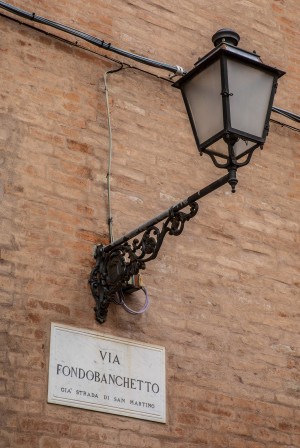Via Fondobanchetto
Road in the old town of Ferrara that goes from Via Porta San Pietra to Via Carlo Mayr.
Name and brief history
According to what was chronicled by Girolamo Melchiorri, the name of this street can be traced to an event that occurred in relation to the rivalry between two of families that were enemies until the definitive rule of the House of Este starting in 1264. Between the 11th and 13th centuries, the city was the stage of bloody clashes between the Guelphs and the Ghibellines, and the main dynasties representing those factions. Via Fondobanchetto was the location of the castle of a Ghibelline family, the Torelli Salinguerra family, of which remains only a part that has been enclosed within a Renaissance building not far from the Church of San Martino. The event that gave rise to the place name in fact occurred in that very place. In June 1240, as the siege of the Ghibelline city under Guelph forces continued, ‘a secretly insidious agreement was reached’ (G. Melchiorri, Nomenclatura ed Etimologia delle Piazze e delle Strade di Ferrara e Ampliamenti all’Opera di Gerolamo Melchiorri, edited by C. Bassi, 2G Editrice, Ferrara 2009, p. 71). During a banquet, ‘at the “fondo” or end of it’ offered by Salinguerra II Torelli at his palace, a trace of which remains at no. 43, he was captured by surprise and taken to Venice, where he died five years later. The street is found on that which was the ‘Fondo Bagolo’ or ‘Bagnolo’.
In literature
In Giorgio Bassani’s Five Stories of Ferrara, the antifascist teacher and title character of ‘Clelia Trotti's Last Days’ was held on house arrest in Via Fondobanchetto. But she isn’t the only protagonist of Bassani's tales to live in that part of Ferrara: not far from there, in Via Salinguerra, stands the humble home of Lida Mantovani, while Geo Josz lives in Via Campofranco in ‘A Memorial Tablet in Via Mazzini’.
Quotes
‘Historically this road was called “Strada di San Martino” (Saint Martin Street) after the church dedicated to that saint, standing until 969, oriented to the west; reinstated and then opened to the east, suppressed and then closed in 1880. It was also called “Strada di San Salvatore” (Christ the Saviour Street) from the other parish, which was open until 954, where now there is the Formignani house at no. 8, at the corner of Via Fossato de Buoi and Via Salinguerra, the church destroyed entirely in 1899.’ (G. Melchiorri, Nomenclatura ed Etimologia delle Piazze e delle Strade di Ferrara e Ampliamenti all’Opera di Gerolamo Melchiorri, edited by C. Bassi, 2G Editrice, Ferrara 2009, p 71) ‘Although finished and near to death, both of them in the end were still dreaming their dreams. From her prison in Via Fondo Banchetto, Clelia Trotti was dreaming that the rebirth of Italian socialism would occur thanks to the infusion of youthful blood into the Party’s old, decrepit veins. From the Ghetto of Via Madama, where with morose delectation he had holed up – the beloved, irreplaceable Merchants’ Club had naturally expelled him, so now he stayed at home reading the newspapers and listening to Radio London – the lawyer Lattes dreamt of the ‘brilliant career’ which was bound to await his little son in America or in Eretz.’ (G. Bassani, ‘Clelia Trotti's Last Days’, in The Novel of Ferrara, translated by Jamie McKendrick, Penguin Classics, 2018, e-book location 2010)
Bibliography
- Luciano Chiappini, Gli Estensi. Mille anni di storia, Corbo, Ferrara 2001
- Giorgio Bassani, Gli ultimi giorni di Clelia Trotti in Opere, Il romanzo di Ferrara, Mondadori 2001
- Melchiorri, Gerolamo, Bassi, Carlo, Nomenclatura ed etimologia delle piazze e strade di Ferrara. Ampliamenti all'opera di Gerolamo Melchiorri, 2G, Ferrara 2009
Compiling entity
- Assessorato alla Cultura e al Turismo, Comune di Ferrara
Author
- Barbara Pizzo

